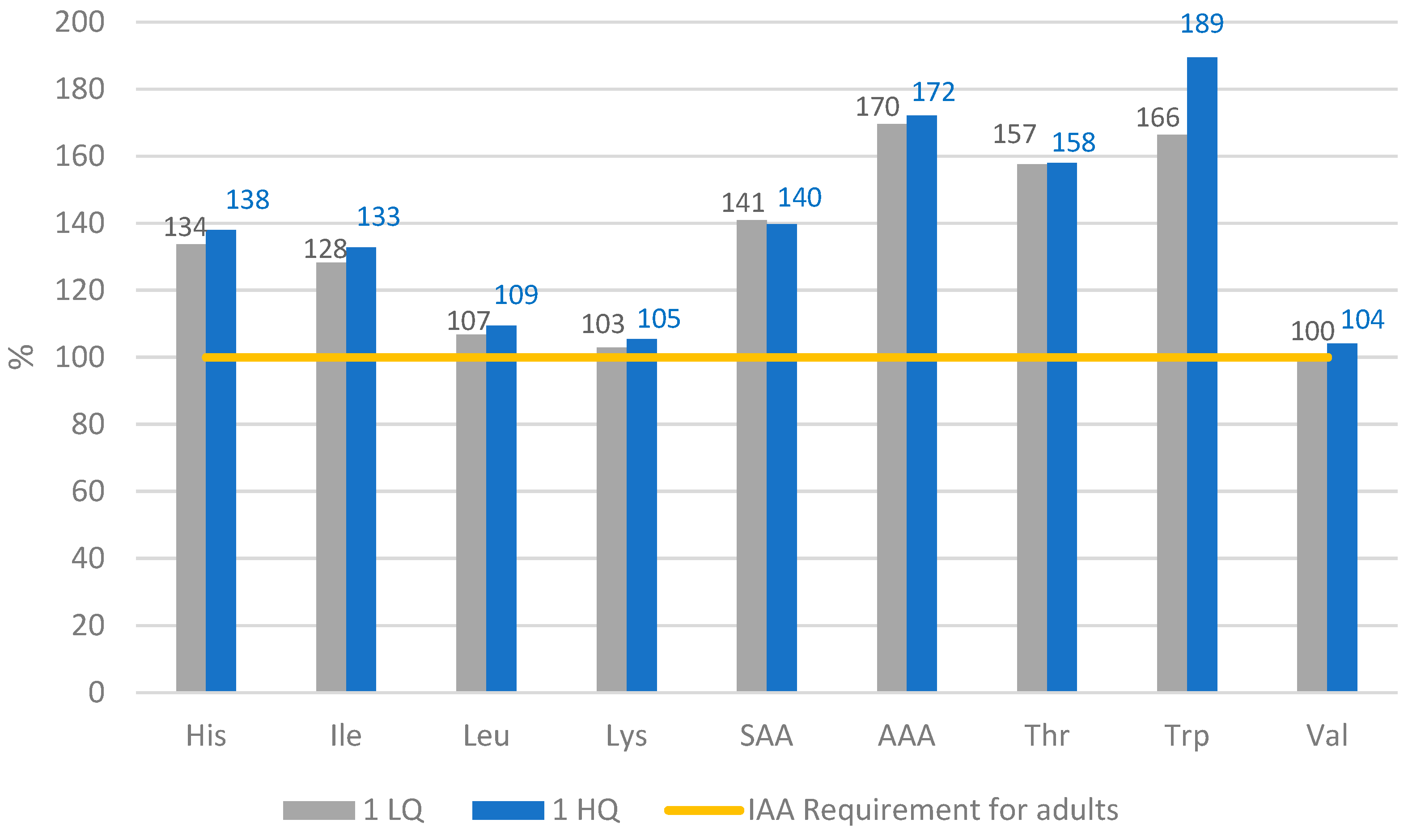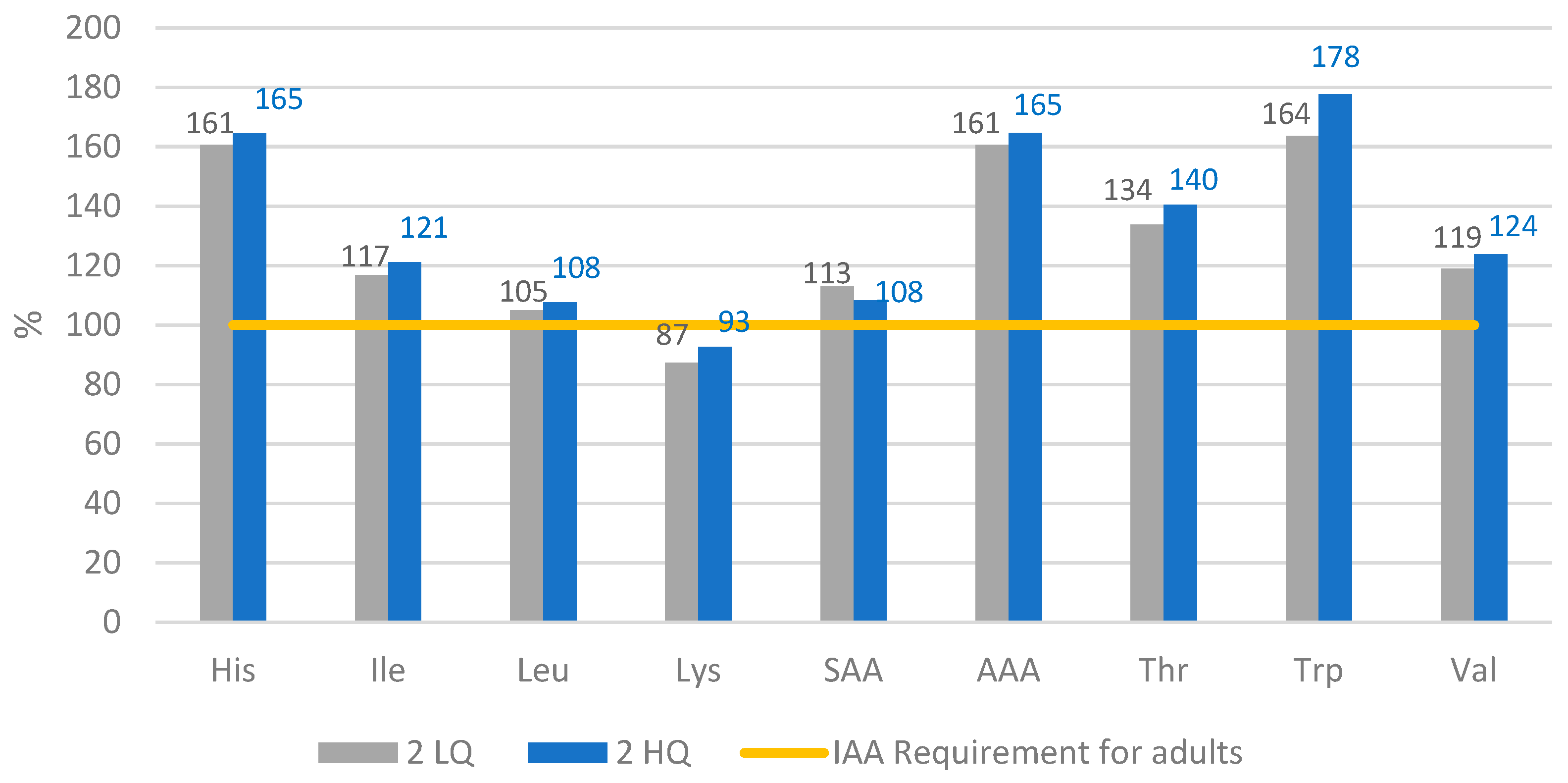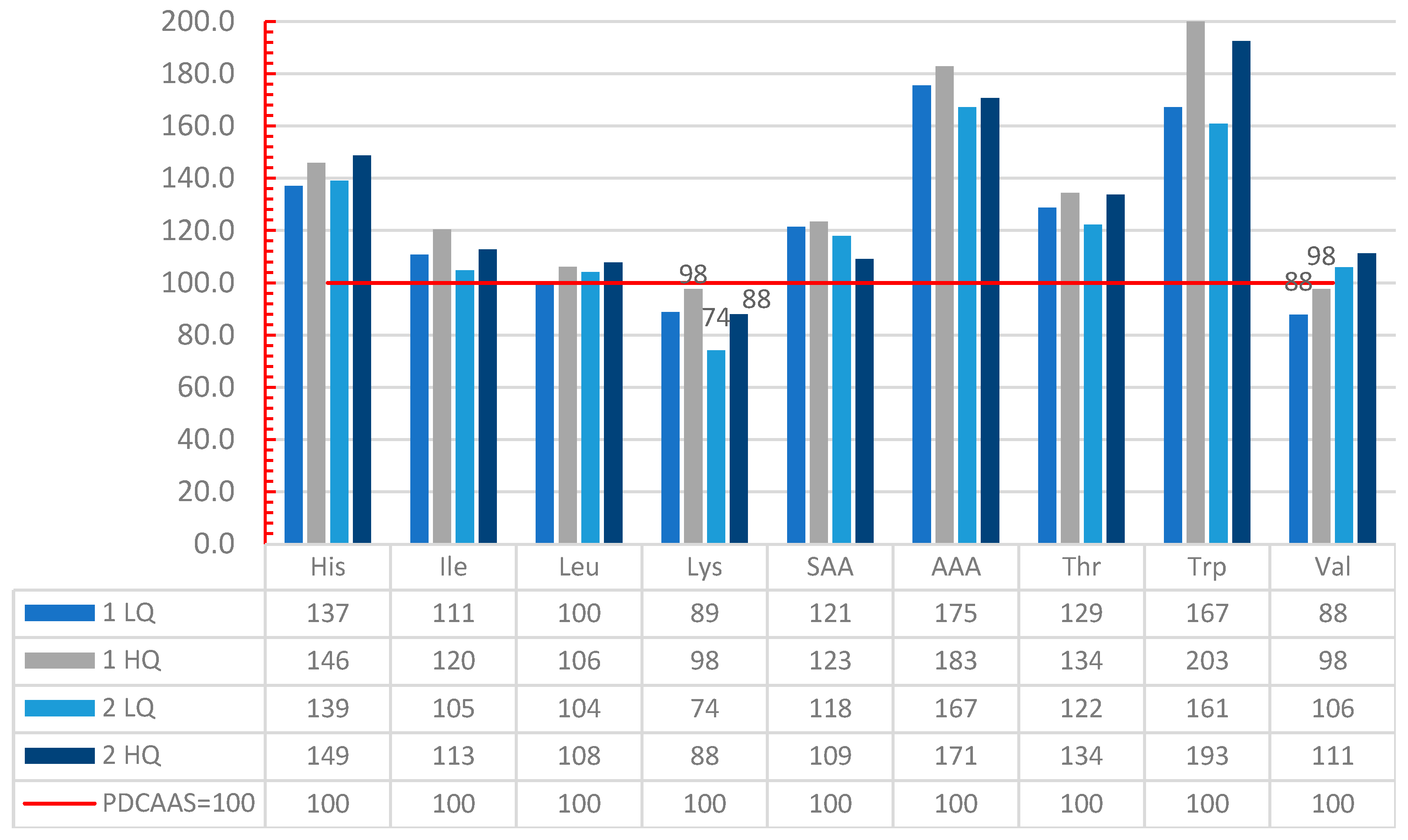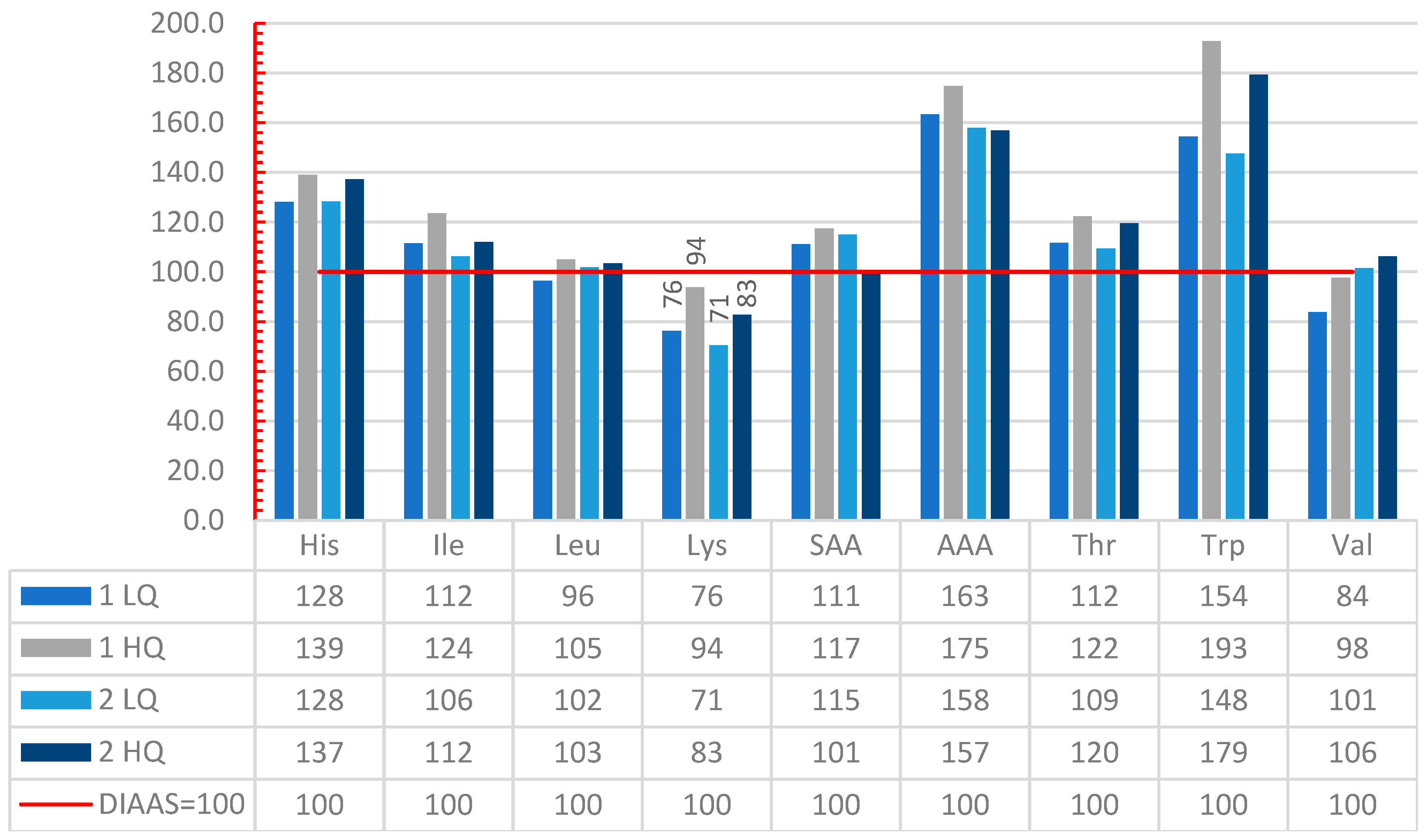1. Introduction
A plant-based diet with a minimum number of animal-sourced foods provides health and environmental benefits. However, there might be a lack in the absorption of certain indispensable amino acids that are important for health. Even though plant foods contain all the nine indispensable amino acids (IAA), the IAA profile may not be optimal according to the established requirements for human needs [
1,
2]. Additionally, the so-called antinutrients may hinder the digestibility of plant-based nutrients [
3]. Protein quality reflects to what extent a food protein source or a diet fulfils the metabolic demand for amino acids and nitrogen, and thus, whether the protein is used efficiently by the body [
4]. To estimate protein quality, two factors are considered: the indispensable amino acid content and digestibility. Digestibility is an attribute that also depends on the individual’s metabolism, but for protein quality estimation purposes, it will be referred to only as the amount of amino acid or protein absorbed by the digestive tract [
4,
5].
There are various methods to evaluate protein quality. The Food and Agricultural Organization of the United Nations (FAO) currently recommends the method of amino acid scoring, for which the Protein Digestibility-Corrected Amino Acid Score (PDCAAS) has been widely used since 1989, when it was first proposed. It uses a reference protein that is thought to meet all indispensable amino acid requirements and compares it with the test protein for a specific age group. It aims to reflect the overall efficiency of protein utilization in terms of digestibility (absorbed proportion of the food protein) and indispensable amino acid profile [
6]. However, it is recognized that the PDCAAS has some limitations. Therefore, the “Digestible Indispensable Amino Acid Score” (DIAAS) was proposed in 2011 as an improved method [
7]. One of the most important new features of the DIAAS method is that it uses a score based on digestibility of individual dietary indispensable amino acids instead of the crude protein. Moreover, it is measured at the end of the small intestine (ileal digestibility), which is a more accurate representation of amino acid digestion and absorption than fecal digestibility in PDCAAS. Nevertheless, if data for amino acid digestibility are not available, values of crude protein digestibility are accepted as an equivalent. The value of protein quality is not truncated, so it is possible to obtain a score above 100 to express extra health benefits unless calculated for a mixed diet or a sole source of food [
7].
The amino acid adequacy of plant-based diets was discussed in a recent review of Mariotti et al., 2019 [
8]. They concluded that traditional vegetarian diets provide sufficient protein and amino acids when the sources are at least minimally varied, but still, a small percentage of vegans may experience insufficient consumption. However, digestibility is generally not contemplated in that study, and it is often argued that the bioavailability of animal-sourced proteins is not similarly to those of plant proteins but might be comparable to the digestibility of plant protein isolates [
8].
In 2019, the EAT-Lancet Commission on Food, Planet and Health proposed a diet (the EAT-Lancet diet) that is both healthy and within planetary boundaries. The diet follows a flexitarian approach, which is constituted predominantly by a diversity of plant-based foods, but it can be adapted to the full spectrum of plant-based diets. It emphasizes the consumption of vegetables, fruit, legumes, whole grains, nuts, and fish and limits red meat and starchy vegetables, while the intake of eggs, poultry, and dairy foods is optional. As only ranges of food groups are given, this is not a rigorous diet nor an exact prescription. It should be adapted to the individual energy requirements, culture, location, demography, and food preferences [
9].
This study aimed to evaluate the changes in dietary protein quality when only low-quality protein is consumed and how the addition of high-quality protein sources influences when consuming exclusively plant-based foods (vegan diet). It is based on a case study in the frame of the EAT-Lancet diet. We estimate the protein quality of two menu days in two scenarios: (1) only “low-quality” protein sources, (2) “low” + “high-quality” protein sources.
2. Materials and Methods
To investigate the protein quality of a vegan diet, certain vegan menus of the EAT-diet were used as examples. Since the EAT-diet should be adapted to the individual and local context, the menus were designed for an individual case of a healthy Swiss male with 78 kg body weight, 30 years of age, moderate level of physical activity, and an average energy requirement of 2500 kcal/day, who consumes a healthy vegan diet. The daily protein requirement was 64.8 g/day, based on an adequate protein intake for adults of 0.83 g/kg body weight per day [
10].
2.1. Menu Creation
First, a list of plant protein sources from different food groups with their respective DIAAS value was created. The list contained only foods available in the Swiss Food Composition Database to be in line with the case study. The list of food items was dichotomized according to the following criteria for judged quality [
7]: DIAAS < 75 was defined as low-quality protein sources (LQPS), DIAAS ≥ 75 as high-quality protein sources (HQPS).
Four different daily menus were made. First, two where only LQPS were used, including five meals: breakfast, lunch, dinner, and two snacks. The portions were set according to the recommendation by the current Swiss Nutrition Policy. The final quantities per day of each food group were set according to the ranges proposed in the EAT-diet and the daily protein requirement (64.8 g).
Afterwards, based on the two menus, a scenario with high-quality protein was made. For this, some of the LQPS were substituted by protein sources with higher DIAAS (
Table 1). Since not many high-quality protein sources were available, foods with higher DIAAS were used to substitute LQPS (not necessarily items with DIAAS > 75). The quantities of food were adjusted to obtain 64.8 g of protein per day for each menu.
On Day 1 LQ, three LQPS foods were substituted with three HQPS. On day 2, four items were substituted in the same manner (
Table 1).
In the menus, the following food items were not considered: water and other liquids; minor ingredients such as sauces, herbs, spices, added oils, and added sugars due to their low or null protein content.
2.2. Calculation of Protein Quality
First, the quantities of dry grains and dry pulses were converted to cooked weight (they were initially in grams of dry grain for the calculation of food ranges according to EAT diet). For black beans, white rice, and brown rice, a ratio of 3:1 cooked to dry was used. For chickpeas, oats, lentils, and quinoa, a ratio of 2:1 cooked to dry was used.
Information about protein and IAA content, true protein digestibility (TPD), and Ileal IAA digestibility were gathered for each food item (
Tables S1 and S2) considering the final state of consumption (e.g., raw, cooked, roasted). Second, the protein quality was calculated in an Excel spreadsheet with the methods PDCAAS and DIAAS for mixed protein sources as described by FAO/WHO/UN (2007) and FAO (2013), respectively, according to the requirements established for adults (
Table 2). The results of PQ ≥ 100 were classified as excellent PQ, of 0.75–0.99 as good, and PQ < 0.75 as low, respectively.
4. Discussion
Protein is an essential component of a healthy diet that allows the correct growth and maintenance of the 25,000 proteins in the human genome. The amount required to fulfil the latter functions is defined as the dietary protein requirement [
4]. Such requirement depends on the metabolic demands of the organism (age, physical activity expenditure, and energy expenditure), as well as the efficiency of utilization of the protein source. Hence, dietary requirement = metabolic demand/efficiency of utilization.
The recommended daily allowance (RDA) to meet the requirements of protein of 97.5% of the healthy adults is 0.8 g/kg body weight per day [
4]. As expected, in this study, the values of PDCAAS were higher than of DIAAS. The reason is that DIAAS values are calculated (when data are available) with ileal digestibility, which is more accurate than fecal digestibility used for PDCAAS, so PDCAAS may overestimate the protein quality. With both methods, 1 HQ had the highest PQ, very close to 100. This indicates that the IAA quantity is very close to that of the requirements.
With both methods, the PQ of the HQ scenarios were classified as good, and with both methods, the PQ of the day 2 LQ was low. In this regard, the results are consistent. However, the protein quality of day 1 LQ was very different with PDCAAS (88) vs DIAAS (76) (
Table 6 and
Table 7). Between methods, the other scenarios had a smaller variation.
Table 1 shows that on day 1, only three food items were substituted (soy drink for almond drink, tofu for beans, and lentils for chickpeas), and this was sufficient to improve the quality by 11% (PDCAAS) and 24% (DIAAS) (
Table 7). The most limiting amino acid in all the scenarios was lysine. Day 2 LQ and HQ were already deficient in this nutrient before considering digestibility. The fact that one scenario with LQPS had good PQ and the other low PQ, can be partly explained by synergies between the different protein sources. The substitution of LQPS with HQPS in this study was made on a gram of protein contribution basis so that the protein quality is comparable. For instance, to obtain the same quantity of protein (9 g), 200 g of cooked chickpeas were substituted with 120 g of cooked lentils because the protein content of lentils is higher. However, when substituting a protein source in practice, it is more likely that the substitution would be one to one, which would result in a higher total protein per day. The resulting protein quality would probably be higher as well since the proportion of HQPS would be greater. In the same manner, it could lead to changes in the intake of energy and other macronutrients. Further research could analyze the impact of substituting LQPS with HQPS on other macronutrients. For instance, replacing 120 g of cooked pasta with 225 g of cooked brown rice (as in Day 2), would result in an increase of carbohydrates (from 35.2 g to 52.9 g, data not shown) and calories (from 174 cal to 252 cal, data not shown) [
20].
There were some limitations in this study. The main challenge was the availability of data on digestibility, especially for fruits and vegetables. Several foods belonging to those groups were assumed to have the same value, e.g., raw carrot and raw apple for both ileal digestibility of IAA and fecal digestibility of crude protein. Furthermore, FAO (2013) recommends measuring digestibility in humans (for DIAAS), but information on these characteristics is scarce [
7]. When data are not available, it is possible to use studies performed in growing pigs or rats. For PDCAAS, the recommended assay is in rats. As not all the food items in this study have digestibility studies in vivo, some data were taken from in vitro studies. However, some studies suggest that in vitro assays provide an accurate estimate of the TPD [
21,
22,
23]. For the estimation of DIAAS, there is no information on individual IAA digestibility for every food item. For these cases, the value of the crude protein digestibility is used instead, as recommended by the FAO (2013) [
7].
Moreover, the calculation relies on the quality of each experimental value for IAA content, IAA ileal digestibility, and crude protein digestibility. Thus, the results might carry considerable compounding errors. Other aspects, such as lack of specific nitrogen-to-protein conversion factors to calculate protein content or not considering the food matrix [
24], remain a limitation, since not enough data to address them are available. According to Craddock et al. [
24], PDCAAS is currently the most appropriate approach for use in Western adults who follow a plant-based diet. For that reason, this method was also used, and the outcomes were compared to DIAAS. The two methodologies showed the same trend, and the final classification (low or high protein quality) was the same. In this work, only 2-day menus were evaluated. However, a 7-day menu would be more robust since all weekdays (including weekends) are represented. Additionally, it was assumed that by following the ranges of the EAT report, the nutrient and energy adequacy is fulfilled, so it was not addressed here.
The menus were designed following the ranges proposed by the EAT-lancet Commission for a healthy diet, so unhealthy food or meat/dairy analogues are not considered. The plates of the menus are all based on whole foods that need a considerable amount of time and skill to be prepared. The question of how realistic and affordable this pattern is, is not addressed in the present study. We only analyzed two days, and a longer diet might be more representative. However, it shows clear tendencies and can be compared to a real diet analysis of vegan people in the future.
One of the strengths of this study is that home processing was considered. The different cooking techniques, such as soaking followed by boiling, generally increase the digestibility of the proteins when compared to the raw food [
25]. The reason is that processing inactivates or reduces the amount of some of the compounds that limit the digestion, namely antinutritional factors and that are present in plant protein sources [
3,
26].
To our knowledge, this is the first study that estimates the DIAAS and PDCAAS of a vegan mixed diet considering also fruits and vegetables. Other studies have evaluated the PQ of mixed diets [
27,
28] but with a more limited database of food items, mainly accounting for grains and legumes and not considering fruits and vegetables. Overlooking those items could lead to underestimating the quality and quantity of protein, especially in plant-based diets [
24,
29]. Furthermore, our findings are in line with a recent study from Salome et al. (2020) that analyzed a representative French national dietary survey with 1341 participants and found that the plant proteins ingested were not very diverse and even less diverse for higher plant protein intake. They further concluded that it is important that the plant-protein origins are diverse and do not originate mostly from refined grains [
30]. It might be also interesting to compare the environmental impact of using high protein quality sources instead of low protein quality sources in the future.
Especially for the elderly and people that have a problem reaching the recommended protein intake amounts, it is very important to consider protein sources with a high protein quality that might even result in beneficial physiological consequences, such as maintaining muscle mass [
31].
In this case, the need for a higher protein intake in the diet, which may be difficult for elderly people or may also result in an increased calorie intake, can be avoided [
31].















